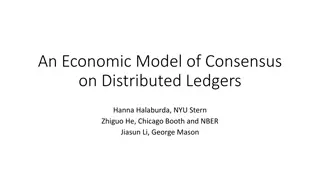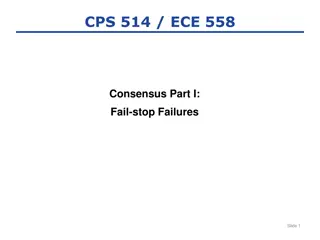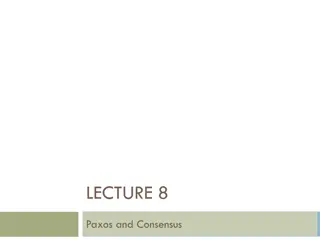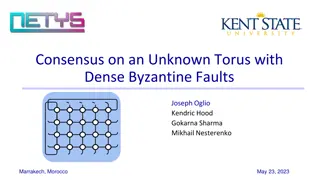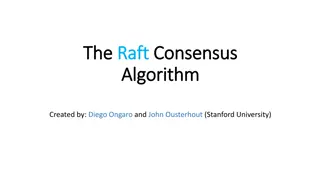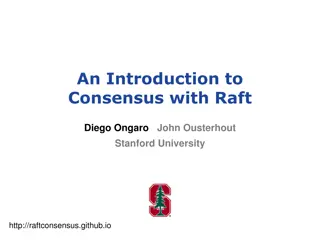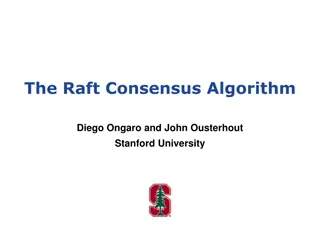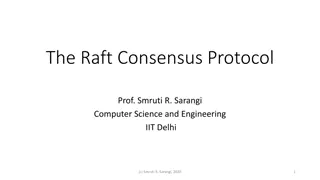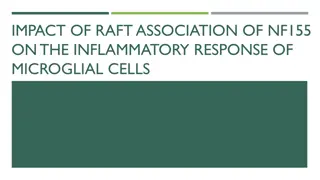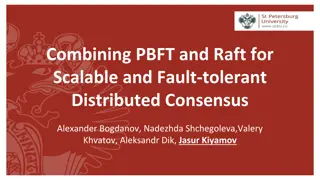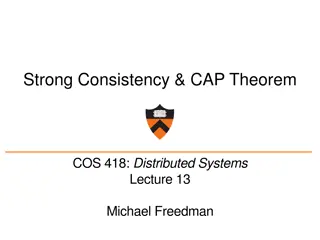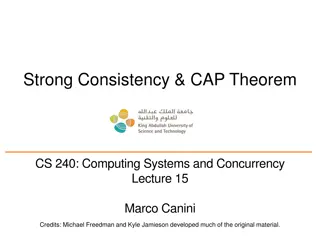Overview of Raft Consensus Algorithm
Raft is a consensus algorithm designed for understanding and building real systems. It ensures agreement on shared state, tolerates server failures, and eliminates single points of failure. Raft simplifies the complexity of state space compared to Paxos, making it performant and understandable for system builders. Explore the key concepts and benefits of Raft in this comprehensive overview.
Download Presentation

Please find below an Image/Link to download the presentation.
The content on the website is provided AS IS for your information and personal use only. It may not be sold, licensed, or shared on other websites without obtaining consent from the author.If you encounter any issues during the download, it is possible that the publisher has removed the file from their server.
You are allowed to download the files provided on this website for personal or commercial use, subject to the condition that they are used lawfully. All files are the property of their respective owners.
The content on the website is provided AS IS for your information and personal use only. It may not be sold, licensed, or shared on other websites without obtaining consent from the author.
E N D
Presentation Transcript
A BAYESIAN METHOD TO ASSESS THE N-MIXTURE MODELS USED IN THE ESTIMATION OF ANIMAL ABUNDANCE Sherwin Toribio University of Wisconsin La Crosse Jason Rubbert University of Wisconsin La Crosse
Outline Background N-Mixture Model Model violations and biased estimates Bayesian method to detect model violations
Background Estimating animal abundance is a major issue in wildlife statistics Two popular sampling methods: Capture-recapture method Extensive literature Can be difficult to implement Simple count method Easier to implement Statistical procedures are more complicated
Simple Count Data Matrix Abundance site visit 1 visit 2 visit 3 . . visit T N1 1 X11 X12 X13 . . X1T N2 2 X21 X22 X23 . . X2T N3 3 X31 X32 X33 . . X3T . . . . . . . . . . . . . . . . . . . . NR R XR1 XR2 XR3 . . XRT
N-Mixture Model (Royle,2004) Observed counts: Xij~ bin(Ni, p) Site-specific abundance: Ni~ pois( ) Closure assumptions Marginal Likelihood function:
Estimation Procedures Classical Approach and p can be estimated by maximizing the marginal likelihood function. Bayesian Approach Inferences about parameters are based on their posterior distributions has prior distribution g( ) (y1 , y2, .,yn) come from f(y| ) has posterior distribution g*( ) f(y| ) g( )
Bayesian Estimation Model: Xij~ bin(Ni,p), Ni~ pois( ) Prior: =logit(p)~ dflat() =log( )~ dflat() Joint posterior distribution
Using MCMC The joint posterior distribution is too complicated to be studied analytically Simulate samples from this joint posterior distribution using MCMC. Employed WinBUGS (10,000 values after burn-in of 1,000 values). Bayesian estimates can be obtained by summarizing the simulated samples.
Simulation Study Employed R with the R2WinBUGS package Different Scenarios No. of sites = (20, 50) = (2, 5, 10) p = (.25, .50) No. of visits = (3, 5, 8)
Bayesian vs. Classical R P N Estimator Median MMLE 40.15 20 2 0.50 40 Bayesian 41.49 MMLE 99.77 20 5 0.50 100 Bayesian 101.03 MMLE 99.75 50 2 0.50 100 Bayesian 102.58 MMLE 249.61 50 5 0.50 250 Bayesian 252.75
Bayesian Estimates R P P estimate estimate 20 2 0.50 2.07 0.4890 50 2 0.50 2.02 0.4947 50 5 0.25 5.17 0.2427 50 5 0.50 5.06 0.4962
N-Mixture Model Assumptions Requires a set of assumptions in order to be accurate Common detection probability, p Can differ with multiple observers Location homogeneity Different location might affect detection probability Population size remains constant Does not consider births, deaths, migration What happens when some of these assumptions are violated?
Pseudo-Replicated Data Data with extra variability Simulate Ni ~ pois( ) Nij= Ni+ bin(m ) bin(m, ) Xij~ bin(Nij,p) Relative increase in variability of Xij. ( ) mp2/p
Simulation Results (=5) (Toribio, Gray, & Liang, 2011)
Simulation Results (=2) (Toribio, Gray, & Liang, 2011)
Simulation Results (=10) (Toribio, Gray, & Liang, 2011)
Simulation Results (p) P R T estimate P estimate 10 .7 20 5 10.03 0.6967 10 (.5, .6, .7, .8, .9) 20 5 16.87 0.4160 10 (.3, .4, .5, .6, .7) 20 5 24.15 0.2101 10 (.1, .2, .3, .4, .5) 20 5 49.07 0.0611 10 (.5, .55, .6, .65, .7) 20 5 11.78 0.5107 10 (.1, .2, .3, .4, .5) 50 5 43.16 0.0692 5 (.5, .6, .7, .8, .9) 20 5 6.04 0.5827 10 (.5, .525, .55, .575, .6, .625, .65, .675, .7) 20 9 11.23 0.5385 20 (.5, .6, .7, .8, .9) 20 5 57.36 0.2448
Some Remarks When the model assumptions are satisfied, the N-mixture model yields accurate estimates. When the closure assumption or the common detection probability are violated, estimates of the average abundance level ( ) are biased high, and estimates of the common detection probability are biased low. How do we know if the data do not satisfy the model assumptions of the N-mixture model?
Posterior Pred. Sampling Discrepancy Measures
Results (X2) P R 20 20 20 20 20 35 50 20 20 T 5 5 5 5 5 5 5 5 9 estimate 10.03 49.07 24.150 16.87 11.780 44.34 43.16 6.040 11.230 P estimate 0.6967 0.06110 0.21010 0.41600 0.5107 0.06778 0.06918 0.5827 0.5385 Power 0* 0.428 0.738 0.957 0.082 0.642 0.794 0.35 0.096 10 10 10 10 10 10 10 5 10 .7 (no violation) (.1, .2, .3, .4, .5) (.3, .4, .5, .6, .7) (.5, .6, .7, .8, .9) (.5, .55, .6, .65, .7) (.1, .2, .3, .4, .5) (.1, .2, .3, .4, .5) (.5, .6, .7, .8, .9) (.5 ->.7; by .25) 20 (.5, .6, .7, .8, .9) 20 5 57.36 0.24480 0.999
Results (X2) Power plot 1.2 1 1 0.8 0.8 0.6 0.6 0.4 0.4 0.2 0.2 0 0 = 5 = 10 = 20 R = 20 R = 35 R = 50
Results (X2) Scenario Estimate P Estimate Power 12.25 0.6327 16.44 0.5132 37.61 0.2589 12.33 0.4688 23.64 0.1981 Inc. abundance; m=1; =.5 Inc. abundance; m=2; =.5 Inc. abundance; m=4; =.5 Dec. abundance; =.1 Dec. abundance; =.2 0.024 0.508 0.981 0.428 0.910 1.5 1 =.2 m=4; =.5 0.5 m=2; =.5 =.1 m=1; =.5 0
Final Remarks / Future Work Bayesian PPMC method is effective in detecting some types of model violations. Find other effective discrepancy measures. Develop new models that will be able to take into account the extra variability.
References Royle, J.A., 2004, N-Mixture Models for Estimating Population Size from Spatially Replicated Counts. Biometrics, 60, 108 115. Royle, J.A. and Dorazio, R.M., 2006, Hierarchical Models of Animal Abundance and Occurrence. Journal of Agricultural, Biological, and Environmental Statistics, 80(4), 423 426. Toribio, S.G., Gray, B.R., and Liang, S., 2009, An Evaluation of the Bayesian approach to fitting the N-Mixture model for use with pseudo-replicated count data. Journal of Statistical Computation & Simulation. R Development Core Team (2006). R: A language and environment for statistical computing. R Foundation for Statistical Computing, Vienna, Austria. ISBN 3-900051-07-0, URL http://www.R-project.org. Lunn, D.J., Thomas, A., Best, N. and Spielgelhalter, D., 2000, WinBUGS a Bayesian modelling framework: concepts, structure, and extensibility. Statistics and Computing, 10, 325 337. URL http://www.mrc-bsu.cam.ca.uk.
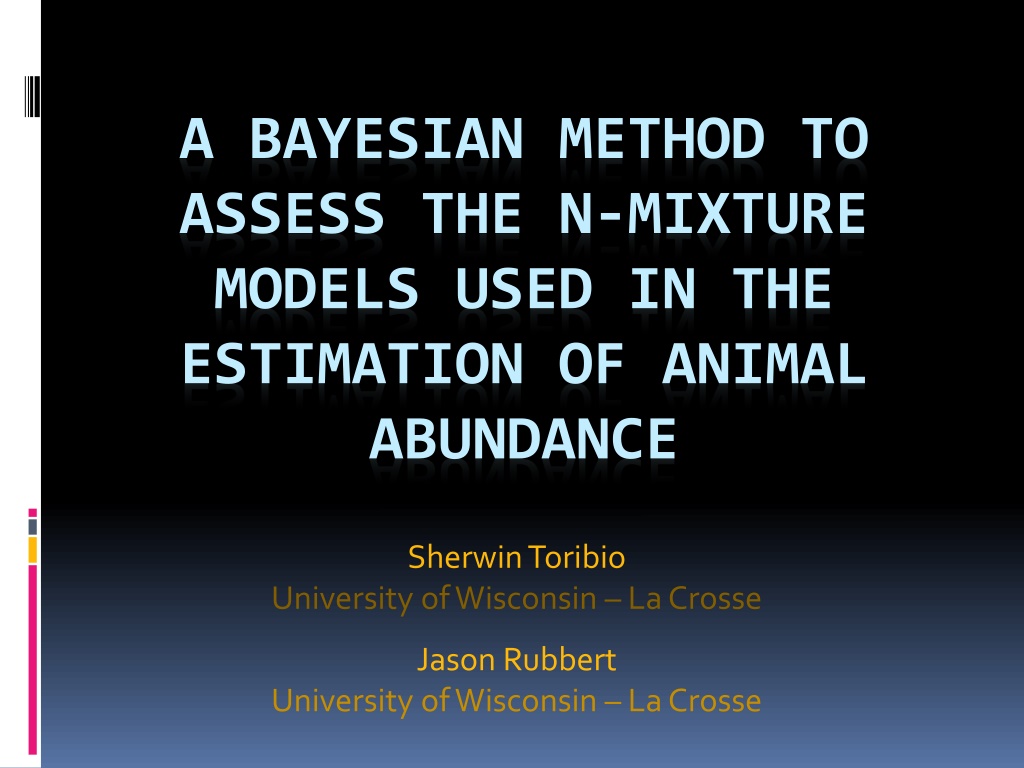
 undefined
undefined












